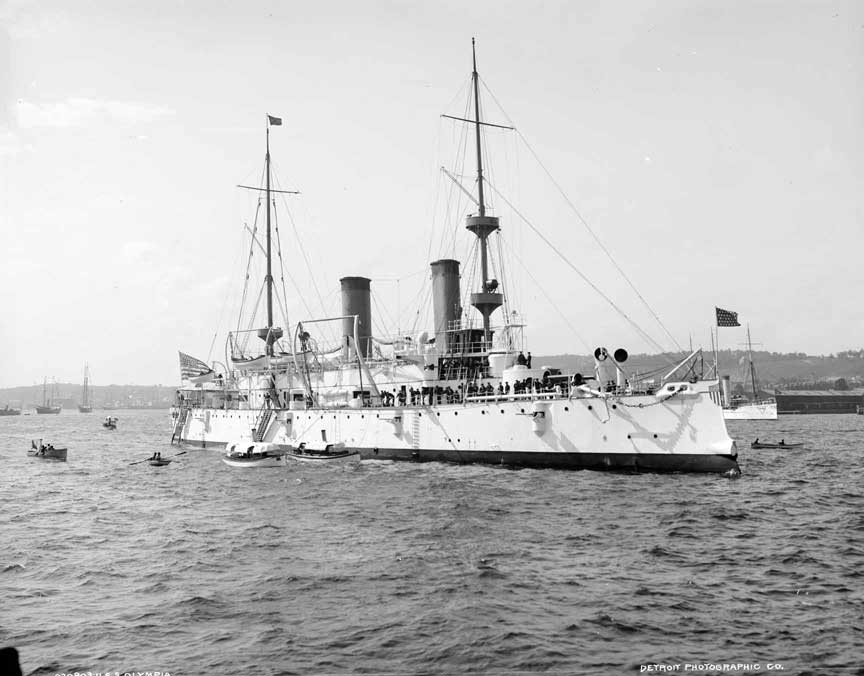USS Olympia C-6

Olympia
(C-6: dp. 5,586,1. 344'1"; b. 53', dr. 21'6" s. 20 k., cpl. 411; a. 4 8", 10 5", 4 6-pdrs., 6 1-pdrs., 6 18'; tt.; cl. Olympia)
Olympia (C-6) was laid down 17 June 1891 by Union Iron Works, San Francisco, Calif., Launched 5 November 1892 sponsored by Miss Ann B. Diekie; and commissioned 5 February 1895, Captain John J. Read in command.
Olympia departed Mare Island 25 August 1895 to join the Asiatic Fleet as flagship. For three years she cruised the Far East, visiting Japan, China, and the Philippines. With Captain Charles V. Gridley in command, she flew the flag of Commodore George Dewey from 3 January 1898. That winter she lay at Hong Kong with the fleet, awaiting orders should war with Spain break out. On 25 April, the day the war was deelared, the squadron moved to Mirs Bay, China. Two days later eame the message which led to Dewey's immortal victory at Manila Bay.
Ships darkened, the fleet safely passed the harbor defenses, and engaged the enemy off Manila at daybreak 1 May. Dewey remembered, "At 5:40 when we were within a distance of 5,000 yards, I turned to Captain Gridley and said, You may fire when you are ready, Gridley'.... The very first gun to speak was an 8 inch ... of the Olympia ...." By noon Spain's Asian fleet had been destroyed with Olympia playing the leading role. The battle was pivotal in the history of the Far East, and thus of the world.
Olympia took part in the blockade and capture of the eity of Manila and covered the Army in repelling insurgent attacks until she returned to the China coast 20 May 1899. Next month she was underway for Suez, the Mediterranean, and Boston, which she reached 10 October. She decommissioned there S November 1899.
Recommissioning in January 1902, Olympia joined the North Atlantic Squadron, serving first as flagship for the Caribbean Division. In the next four years, she roved the Caribbean, Atlantic, and Mediterranean, protecting American citizens and interests from danger in the political strife and turmoil troubling this period. She was off Panama (December 1903-March 1904), Tangiers (June 1904), Smyrna, Turkey (August 1904), and Santo Domingo (May-December 1905), on the alert for any threat.
For six years, beginning 2 April 1906, Olympia was out of commission first at Norfolk, then at Annapolis, recommissioning three summers for midshipmen training cruises (15 May26 August 1907 l June-1 September 1908, 14 May-28 August 1909). SXe arrived Charleston, S. C. 6 March 1912, to serve as barracks ship for the reserve torpedo group.
As war eame closer to the United States, Olympia recommissioned in late 1916 and became flagship, Patrol Force Atlantic Fleet, 13 April 1917. She patrolled off Nova Seotia and escorted convoys before departing Charleston 28 April 1918 for Murmansk, Russia. There on 24 May 1918, she joined an allied force during the crisis brought on by Russia's revolution and her peace treaty with Germany. Olympia landed sailors to garrison Murmansk, and contributed others to the Allied expedition on Arehangel.
At war's end she sailed for Portsmouth, England, and then the Mediterranean. She cruised principally in the Adriatic from 21 January 1919 to 25 October, policing the Dalmation coast which was wracked with turmoil in the wake of the collapse of the Austro-Hungarian Empire. On 18 August she sailed for the Black Sea to aid refugees before returning to the Adriatie 19 September. On 23 September, she sent a landing party ashore at Trau to prevent a clash between Yugoslavs and Italians.
Returning to Charleston 24 November 1919, Olympia prepared for further Adriatie duty, departing New York 14 February 1920. Home again at Philadelphia 25 May 1921 she became flagship of the Train, Atlantic Fleet, the next month. She took part that July in the Army-Navy experiments which sank ex-German warships Frankfurt and Ostfriesland off the Virginia Capes.
On 3 October 1921 Olympia departed Philadelphia for LeHavre to bring the remains of the Unknown Soldier home for interment in Arlington National Cemetery. The cruiser sniled for home 25 October 1921, escorted by a group of French destroyers for the first leg of the passage. At the mouth of the Potomae on 9 November North Dakota (BB-29) and Bernadou (DD-163) joined her as she stood up to the Washington Navy Yard. There with full and somber military honors, the body was piped over the side, Olympia firing a last salute.
After training midshipmen in the summer of 1922, Olympia decommissioned at Philadelphia 9 December 1922. She was Reclassified IX-40 on 30 June 1931. The Navy's oldest steel ship still afloat is perserved as a shrine at Philadelphia by the Cruiser Olympia Association, to which title was transferred 11 September 1957.
 >
>